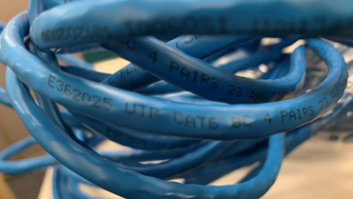(click thumbnail)
(click thumbnail)
(click thumbnail)
(click thumbnail)In reviewing my collection of Radio World columns, it occurs to me that although I’ve written about a thousand things, I’ve not written a column of basics.
What’s the difference between wire and cable? What? You don’t know? They must be different or we wouldn’t say “wire and cable.” Wire is a single conductor. Cable is a group of two or more insulated conductors. (If they weren’t insulated from one another, they’d still form a single stranded wire.)
That’s why we call it coax cable, and not coax wire; there are two conductors in that cable, the center and the shield. Twisted pairs are cables for the same reason. They contain two conductors. And there have to be two wires to make a circuit.
What do I mean by that?
A helpful conductor
Look at Fig. 1. It shows a battery and a light bulb. To connect the battery to the bulb we need two separate conducting elements. I purposely didn’t say two wires, because that’s not always true.
Look at your car, for instance. One terminal goes to the metal of the car, the other is carried on wires. Very efficient. A flashlight often is wired the same way. The metal shell is one conductor and a single wire is the other. But there are always two conductive paths to complete the circuit.
In Fig. 1, I have shown the two conductive paths above as two wires. Bare wires would be just fine because the air around them is an excellent insulator, second only to a vacuum, so there is no connection between the two wires except for the one we physically create by attaching them.
If we now graph the electrical flow, it would look like Fig. 2. (You PhDs who want to tell me about voltage and current moving in opposite directions – well, you just sit on your hands for a while.)
The electrons come out of the negative terminal and travel through the light bulb and back the other way to the positive terminal. And the light bulb lights up.
Around the circle
Of course, the electrons don’t actually move at all. They trade a charge from one atom to the next.
Only atoms with lots of “free” electrons, called valence electrons, can do this. Atoms with tightly held electrons resist moving charges. Materials with lots of valence electrons are called conductors. Those with tightly held electrons are called insulators. And then there are materials that can change from an insulator to a conductor by having an electrical change applied. These are called semiconductors, and you probably wouldn’t have a job these days without them.
But you will note that the arrows are pointing in different directions. This is a “circle” of electricity, which we call a circuit, based on the Latin circuitus, meaning “a going around,” and circulus, a circle.
This is no different than a racetrack. If you are driving on one side and look over to the other side, you will see drivers going in the opposite direction. But don’t turn around. Big accident.
If we now move the wire so they are easier for us to place, such as Fig. 3. Nothing has changed. And if we twist the wires together, as in Fig. 4, still nothing has changed. Of course, it’s a lot easier to connect twisted wires because you can move them two at a time.
Maybe the only change in Fig. 4 is the fact that the wires must now be insulated, covered with a non-conducting layer. If they weren’t insulated, the electricity would take the path of least resistance (i.e. where they touch) instead of the light bulb, which has a much higher resistance. If that happened, the circuit wouldn’t be as long as we want it to be. It would be a short circuit.
We’ll look at more wire and cable terminology in a future column.
















